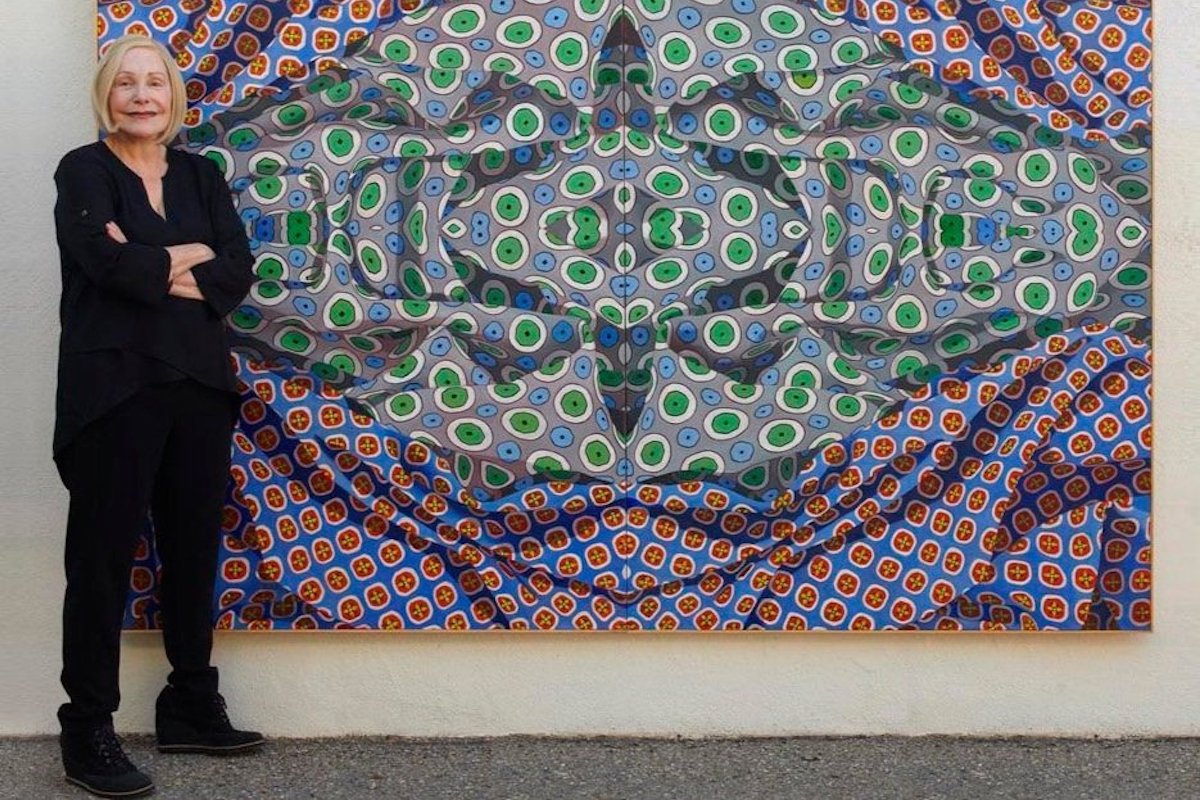
Paying homage to a painter and their work is a humbling task, especially when the artist is Dorothy Churchill-Johnson, who recently passed away in Santa Barbara, her home and artist studio for nearly 50 years. She held not only a special place of honor in the national landscape of American painters, but also in the hearts of the creative community in which she worked. Everyone who knew or admired her, or collected her work will miss her talent, dedication to the arts, and her vibrant intellect. She carved out a style of painting that is challenging to label or artistically to match.
The only way to describe her paintings is to imagine what you might see if you tripped and fell flat on a sidewalk and opened your eyes and saw a tiny pebble, a bug, and a blade of grass resting in a crack. At eye level, the objects seem larger than you ever imagine them upright and more important to the pavement below that held your steps before you fell. How interesting. Or perhaps you buy a tweed jacket and find one tiny thread dangling. As you try to put it back in place, you notice thousands of threads that create a pattern. The jacket becomes more meaningful in its detail than the person who might wear it. Hence, Dorothy’s headless, Neo-Pop men’s-suit series, which, like all of her work, attracts international attention from gallerists and collectors. Taking this imagery one step further, if you have had the good fortune to stand beside one of her giant 5’ x 6’ canvases of the inner images in a kaleidoscope, you will not only feel very small, you might also experience what it feels like to be part of the light reflections on colorful stones and gems.

Dorothy’s paintings help us understand the details and patterns of our environment, the close-up views we might take for granted — the moth in the leaves, the flower’s petal, or the thread in the tweed. “Through observation I hope to elevate the mundane to the extraordinary,” she indicated in an interview. Dorothy elevated what the pedestrian eye might miss when focusing only on the whole. All details mattered. Dorothy took nothing for granted in creating her art or her life.
Dorothy was influenced by and respected many styles. She verged on the hyper-reality of surrealism, pop art, and a type of abstraction of the real world that is still recognizable to its original make-up. Her unique approach was, and still is, of significant interest to many corporations, hotels, institutions, and individual collectors who acquired her work.
In 2021, the Butler Institute of American Art, the first museum dedicated exclusively to American art, flew Dorothy to Youngstown, Ohio, to unveil her painting, “Wind at the Door,” which the Butler had just acquired. Before 700 attendees at their annual Founders Dinner, Dorothy spoke about art and her unique style of painting. The Butler was established 100 years ago as part of a network of lending museums valuable works of American art for exhibitions. Being selected for this august museum, Dorothy’s work will be able to tour and be viewed by thousands of visitors to many museums in perpetuity.
Dorothy was more than her artistry. As a woman, friend, colleague, and a socially conscious and responsible citizen, she could converse on multiple subjects with a stunning intellect, wit, and humor. She loved to read an array of books, not just ones on the arts. Her weekly staple was the New Yorker magazine — read cover to detailed cover. After all, she was born, raised, and educated on the East Coast. She had a degree in Fine Arts from the University of Massachusetts. Yet, Santa Barbara was the place she loved and called home.

As a leading part of the Santa Barbara arts community, Dorothy was a founding board member and president emeritus of Santa Barbara Studio Artists. Most recently she helped to form WE, a collective of established women artists on the Western Edge of America — Santa Barbara. This group includes her friends and colleagues Pamela Hill Enticknap, Nancy Gifford, Ruth Ellen Hoag, Cynthia James, RT Livingston, Cynthia Martin, Joan Rosenberg-Dent, Kerrie Smith, Marlene Struss, Susan Tibbles, and Veronica Walmsley. Dorothy added her talent to this powerhouse collective, yet like her approach to painting, each member artist was as important and significant to her as the whole group together.
Dorothy was 80 years old when she died of a progressive illness. She leaves an extended family of close friends and two nieces. A tree at the northeast point of Mission and Santa Barbara streets has been chosen by Santa Barbara Beautiful to honor Dorothy as one of Santa Barbara’s most prominent artists.

You must be logged in to post a comment.